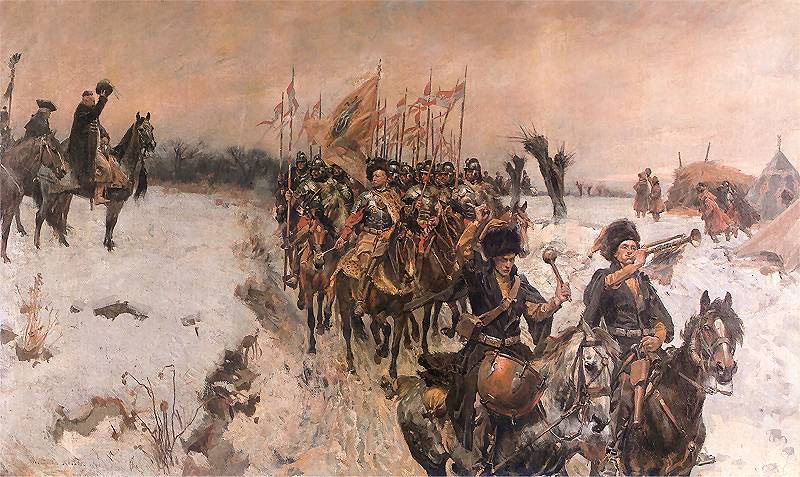Chorągiew on:
[Wikipedia]
[Google]
[Amazon]
 Chorągiew (; literally: "banner") was the basic administrative unit of the Polish and Lithuanian cavalry from the 14th century. An alternative name until the 17th century was ''
Chorągiew (; literally: "banner") was the basic administrative unit of the Polish and Lithuanian cavalry from the 14th century. An alternative name until the 17th century was ''
File:Chorągiew grodzieńska.JPG, District Banner of the Land of
''Winged Hussars''
Radoslaw Sikora, Bartosz Musialowicz, ''BUM Magazine'', October 2016. Military history of the Polish–Lithuanian Commonwealth Polish cavalry {{Europe-mil-stub
 Chorągiew (; literally: "banner") was the basic administrative unit of the Polish and Lithuanian cavalry from the 14th century. An alternative name until the 17th century was ''
Chorągiew (; literally: "banner") was the basic administrative unit of the Polish and Lithuanian cavalry from the 14th century. An alternative name until the 17th century was ''Rota
Rota or ROTA may refer to:
Places
* Rota (island), in the Marianas archipelago
* Rota (volcano), in Nicaragua
* Rota, Andalusia, a town in Andalusia, Spain
* Naval Station Rota, Spain
People
* Rota (surname), a surname (including a list of peop ...
''.

14th to 17th centuries
Between the 14th and 17th century the ''Chorągiew'' was composed of smaller sub-units – the ''Poczet Poczet (, "fellowship" or "retinue"; plural ''poczty'') was the smallest organized unit of soldiers in the and later also the Grand Ducal Lithuanian Army from the 15th until the 18th century. The name of a medium or heavy-cavalry soldiers in poczet ...
''.
Types of ''Chorągiew'' were:
* Chorągiew ziemska (District banner), formed by knights of a district.
* Chorągiew rodowa (Clan banner), formed by clans
A clan is a group of people united by actual or perceived kinship
and descent. Even if lineage details are unknown, clans may claim descent from founding member or apical ancestor. Clans, in indigenous societies, tend to be endogamous, mea ...
.
* Chorągiew nadworna (Court banner), formed by troops of the King.
15th century (2nd half) to 18th century (1st half)
In the cavalry, since the second half of the 15th century until the first half of the 18th century, a ''Chorągiew'' was formed according to the "companion system" (system zaciągu towarzyskiego). See: ''Towarzysz
Companion (Polish: ''Towarzysz'' ), plural: ''towarzysze'') was a junior cavalry officer or knight-officer in the army of the Polish–Lithuanian Commonwealth from the 16th century until its demise in 1794.
Name
During the 20th century, ''towa ...
'' (companion).
Types of ''Chorągiew'' were:
* Chorągiew husarska (Hussar banner), formed by Hussars
A hussar ( , ; hu, huszár, pl, husarz, sh, husar / ) was a member of a class of light cavalry, originating in Central Europe during the 15th and 16th centuries. The title and distinctive dress of these horsemen were subsequently widely a ...
.
* Chorągiew lekka ("Light" banner), formed by light-cavalry.
* Chorągiew pancerna ("Armoured" banner), formed by Pancerni
Armoured companion (Polish: ''Towarzysz pancerny'' , plural: ''towarzysze pancerni'') was a medium-cavalryman in 16th to 18th century Poland, named after their chainmail armor. These units were the second-most-important (and successful) cavalry in ...
.
* Chorągiew tatarska (Tatar banner), formed by Tatars
The Tatars ()Tatar
in the Collins English Dictionary is an umbrella term for different Turki ...
.
* Chorągiew wołoska (Vlach banner), light cavalry, not only formed by in the Collins English Dictionary is an umbrella term for different Turki ...
Vlachs
"Vlach" ( or ), also "Wallachian" (and many other variants), is a historical term and exonym used from the Middle Ages until the Modern Era to designate mainly Romanians but also Aromanians, Megleno-Romanians, Istro-Romanians and other Easte ...
.
* Chorągiew kozacka (Cossack banner), light cavalry, not only formed by Cossacks
The Cossacks , es, cosaco , et, Kasakad, cazacii , fi, Kasakat, cazacii , french: cosaques , hu, kozákok, cazacii , it, cosacchi , orv, коза́ки, pl, Kozacy , pt, cossacos , ro, cazaci , russian: казаки́ or ...
.
Typical family/village clans of the Chorągiew Rodowa who provided men for battles consisting of approximately 100 men were:
* Topór, Dołęga and Gryf
Gryf ( Polish for "Griffin"), also known as Jaxa, is a Polish coat of arms that was used by many noble families in medieval Poland and later under the Polish–Lithuanian Commonwealth, branches of the original medieval Gryfita-Świebodzic famil ...
Gallery
Grodno
Grodno (russian: Гродно, pl, Grodno; lt, Gardinas) or Hrodna ( be, Гродна ), is a city in western Belarus. The city is located on the Neman River, 300 km (186 mi) from Minsk, about 15 km (9 mi) from the Polish b ...
(1613–1619)
File:Choragiew-husarska.png, A Hussar banner during the Battle of Kircholm
The Battle of Kircholm ( lt, Salaspilio mūšis; ) was one of the major battles in the Polish–Swedish War (1600–1611). The battle was decided in 20 minutes by the devastating charge of Polish-Lithuanian cavalry, the Winged Hussars. The ba ...
in 1605
File:Kłuszyn 1610.JPG, A Hussar banner during the Battle of Kluszyn
The Battle of Klushino, or the Battle of Kłuszyn, was fought on 4 July 1610, between forces of the Polish–Lithuanian Commonwealth and the Tsardom of Russia during the Polish–Muscovite War, part of Russia's Time of Troubles. The battle occ ...
in 1610
References
* PWN Leksykon: Wojsko, wojna, broń, Wydawnictwo Naukowe PWN, Warszawa 2001,''Winged Hussars''
Radoslaw Sikora, Bartosz Musialowicz, ''BUM Magazine'', October 2016. Military history of the Polish–Lithuanian Commonwealth Polish cavalry {{Europe-mil-stub